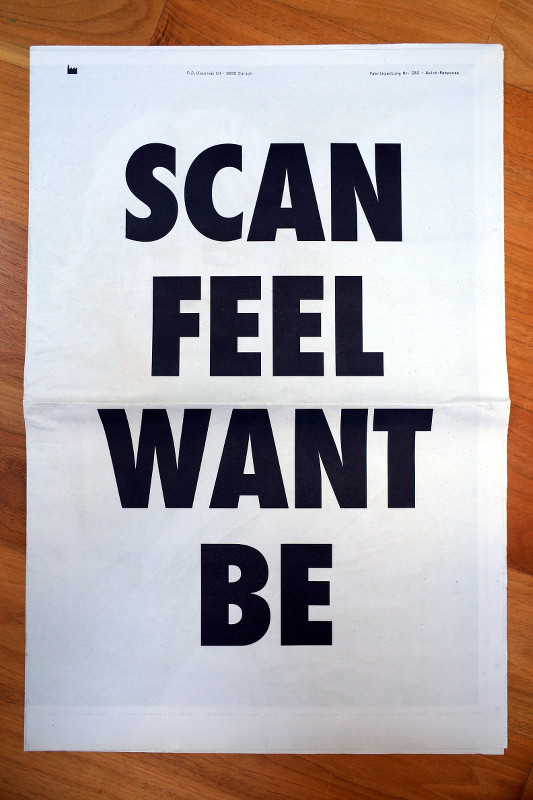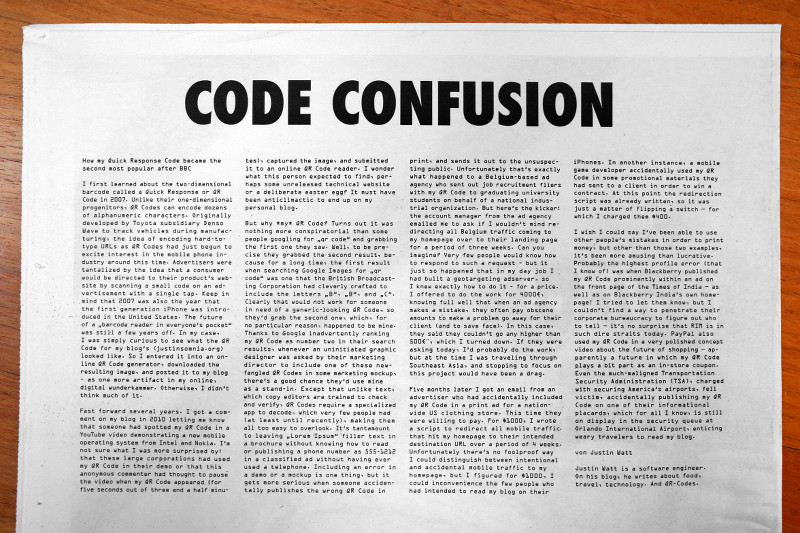Code Confusion
I received an email from an editor at Fabrikzeitung, a monthly magazine published in Zurich, Switzerland by Rote Fabrik. They were planning an issue about QR Codes and asked whether I would write an article expanding upon my post, Why does that QR Code go to justinsomnia.org? Of course! As an aside: I believe this is the first article I’ve ever been commissioned to write—and got paid for.
Well, they sent me an actual physical copy of the issue, and it looks very cool.

Here’s my article.

For those who might be curious, you can read the full text here:
Code Confusion
How my Quick Response Code became the second most popular after BBC
I first learned about the two-dimensional barcode called a Quick Response or QR Code in 2007. Unlike their one-dimensional progenitors, QR Codes can encode dozens of alphanumeric characters. Originally developed by Toyota subsidiary Denso Wave to track vehicles during manufacturing, the idea of encoding hard-to-type URLs as QR Codes had just begun to excite interest in the mobile phone industry around this time. Advertisers were tantalized by the idea that a consumer would be directed to their product’s website by scanning a small code on an advertisement with a single tap. Keep in mind that 2007 was also the year that the first generation iPhone was introduced in the United States. The future of a “barcode reader in everyone’s pocket” was still a few years off. In my case, I was simply curious to see what the QR Code for my blog’s URL http://justinsomnia.org/ looked like. So I entered it into a online QR Code generator, downloaded the resulting image, and posted it to my blog — as one more artifact in my online, digital wunderkammer. Otherwise, I didn’t think much of it.
Fast forward several years. I got a comment on my blog in 2010 letting me know that someone had spotted my QR Code in a YouTube video demonstrating a new mobile operating system from Intel and Nokia. I’m not sure what I was more surprised by: that these large corporations had used my QR Code in their demo or that this anonymous commenter had thought to pause the video when my QR Code appeared (for five seconds out of three and a half minutes), captured the image, and submitted it to an online QR Code reader. I wonder what this person expected to find, perhaps some unreleased technical website or a deliberate easter egg? It must have been anticlimactic to end up on my personal blog.
But why *my* QR Code? Turns out it was nothing more conspiratorial than someone Googling for “qr code” and grabbing the first one they saw. Well, to be precise they grabbed the second result, because for a long time, the first result when searching Google Images for “qr code” was one that the British Broadcasting Corporation had cleverly crafted to include the letters “B”, “B”, and “C”. Clearly that would not work for someone in need of a generic-looking QR Code, so they’d grab the second one, which, for no particular reason, happened to be mine. Thanks to Google inadvertently ranking my QR Code as number two in their search results, whenever an uninitiated graphic designer was asked by their marketing director to include one of these newfangled QR Codes in some marketing mockup, there’s a good chance they’d use mine as a stand-in. Except that unlike text, which copy editors are trained to check and verify, QR Codes require a specialized app to decode, which very few people had (at least until recently), making them all too easy to overlook. It’s tantamount to leaving “Lorem Ipsum” filler text in a brochure without knowing how to read or publishing a phone number as 555-1212 in a classified ad without having ever used a telephone.
Including an error in a demo or a mockup is one thing, but it gets more serious when someone accidentally publishes the wrong QR Code in print, and sends it out to the unsuspecting public. Unfortunately that’s exactly what happened to a Belgium-based ad agency who sent out job recruitment fliers with my QR Code to graduating university students on behalf of a national industrial organization. But here’s the kicker: the account manager from the ad agency emailed me to ask if I wouldn’t mind redirecting all Belgium traffic coming to my homepage over to their landing page for a period of three weeks. Can you imagine? Very few people would know how to respond to such a request — but it just so happened that in my day job I had built a geotargeting adserver, so I knew exactly how to do it — for a price. I offered to do the work for 4000€, knowing full well that when an ad agency makes a mistake, they often pay obscene amounts to make a problem go away for their client (and to save face). In this case, they said they couldn’t go any higher than 500€, which I turned down. If they were asking today, I’d probably do the work, but at the time I was traveling through Southeast Asia, and stopping to focus on this project would have been a drag.
Five months later I got an email from an advertiser who had accidentally included my QR Code in a print ad for a nationwide US clothing store. This time they were willing to pay. For $1000, I wrote a script to redirect all mobile traffic that hit my homepage to their intended destination URL over a period of 4 weeks. Unfortunately there’s no foolproof way I could distinguish between intentional and accidental mobile traffic to my homepage, but I figured for $1000, I could inconvenience the few people who had intended to read my blog on their iPhones. In another instance, a mobile game developer accidentally used my QR Code in some promotional materials they had sent to a client in order to win a contract. At this point the redirection script was already written, so it was just a matter of flipping a switch — for which I charged them $400.
I wish I could say I’ve been able to use other people’s mistakes in order to print money, but other than those two examples, it’s been more amusing than lucrative. Probably the highest profile error (that I know of) was when Blackberry published my QR Code prominently within an ad on the front page of the Times of India — as well as on Blackberry India’s own homepage! I tried to let them know, but I couldn’t find a way to penetrate their corporate bureaucracy to figure out who to tell — it’s no surprise that RIM is in such dire straits today. PayPal also used my QR Code in a very polished concept video about the future of shopping — apparently a future in which my QR Code plays a bit part as an in-store coupon. Even the much-maligned Transportation Security Administration (TSA), charged with securing America’s airports, fell victim, accidentally publishing my QR Code on one of their informational placards, which for all I know, is still on display in the security queue at Orlando International Airport, enticing weary travelers to read my blog.
von Justin Watt
Justin Watt is a software engineer. On his blog, he writes about food, travel, technology. And QR-Codes.